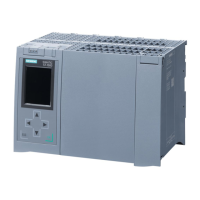Using PID_Temp
6.4 Cascade control with PID_Temp
PID control
Function Manual, 03/2017, A5E35300227-AC
193
Observe the following points during program creation:
● Number of PID_Temp instances
The number of different PID_Temp instances called up in a cyclic interrupt OB has to
agree with the number of concatenated measured variables in the process.
There are two concatenated measured variables in the example: TempChocolate and
TempWater. Therefore two PID_Temp instances are required.
● Call sequence
A master has to be called before its slaves in the same cyclic interrupt OB.
The outermost master at which the user setpoint is specified is called first.
The slave whose setpoint is specified by the outermost master is called next, etc.
The innermost slave that acts on the actuator of the process with its output value is called
last.
In the example, PID_Temp_1 is called before PID_Temp_2.
● Interconnection of the measured variables
The outermost master is interconnected with the outermost measured variable that is to
be regulated to the user setpoint.
The innermost slave is interconnected with the innermost measured variable that is
influenced directly by the actuator.
Interconnection of the measured variables with PID_Temp is carried out with the
parameters Input or Input_PER.
In the example, the outermost measured variable TempChocolate is interconnected with
PID_Temp_1 and the innermost measured variable TempWater with PID_Temp_2.
● Interconnection of the output value of the master to the setpoint of the slave
The output value (OutputHeat) of a master has to be assigned to the setpoint (Setpoint)
of its slave.
This interconnection can be carried out in the programming editor or automatically in the
Inspector window of the slave in the basic settings via the selection of the master.
If required, you can insert your own filter or scaling functions, for example in order to
adapt the output value range of the master to the setpoint/process value range of the
slave.
In the example, OutputHeat of PID_Temp_1 is assigned to Setpoint of PID_Temp_2.

